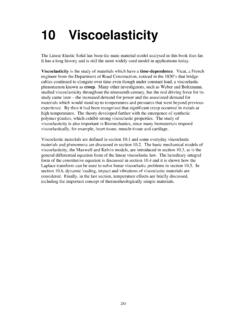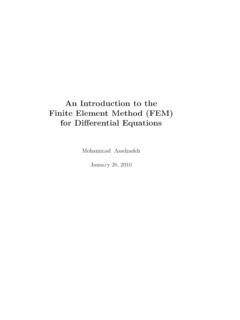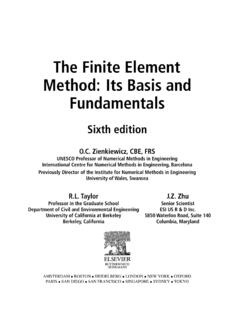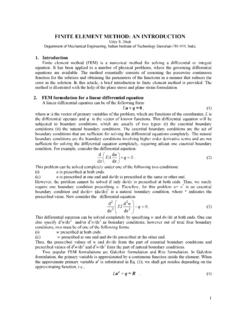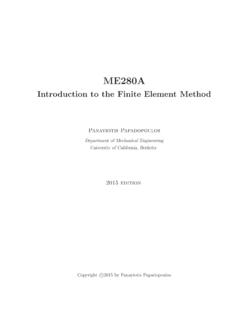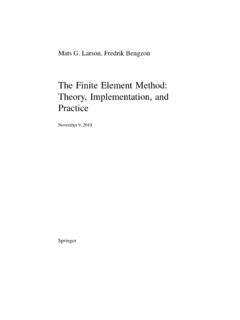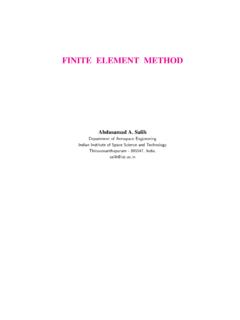Transcription of 2 The (Galerkin) Finite Element Method - Auckland
1 Chapter 2 The Finite Element Method Kelly 312 The ( galerkin ) Finite Element Method Approximate Solution and Nodal Values In order to obtain a numerical solution to a differential equation using the galerkin Finite Element Method (GFEM), the domain is subdivided into Finite elements . The function is approximated by piecewise trial functions over each of these elements . This is illustrated below for the one-dimensional case, with linear functions used over each Element , p being the dependent variable. Figure : A mesh of N one dimensional Finite elements nodes elements true solution approximating functions Element i node i node i+1 ip1 ipip1 ipChapter 2 The Finite Element Method Kelly 32 The unknowns of the problem are the nodal values of p, ip 11 Ni , at the Element boundaries (which in the 1D case are simply points). The (approximate) solution within each Element can then be constructed once these nodal values are known. Trial Functions Lagrange and Hermite elements There are an endless number of different trial functions which one can use.
2 In practice, these trial functions can be grouped into two broad types. The first consists of the Lagrange or 0C trial functions (and corresponding Lagrange or 0C Element ). These are trial functions which are continuous across Element boundaries, but whose first derivatives are not continuous across boundaries. The elements in Fig. are 0C linear elements there is a clear jump in the first derivative of the trial functions at the Element boundaries (nodes) the first derivative is piecewise continuous. The second group consists of the Hermite or 1C trial functions ( elements ). These are functions which are not only continuous across Element boundaries, but whose first derivatives are also continuous across boundaries. In general, a nC Element is one for which the trial functions are continuous up to the thn derivative, but elements with 1 n are rarely used. In fact, three of the most commonly encountered types of Element are those with a (1) linear Lagrange trial function (0C) (2) quadratic Lagrange trial function (0C) (3) cubic Hermite trial function (1C) These three trial functions / elements will be discussed in what follows.
3 Obviously, the higher the order and the higher the continuity of the Element , the better the accuracy one would expect, but the more computation which is required. The C0 Linear Element The 0C linear Element is by far the most commonly used Finite Element . Consider one typical Element of the domain, with end-points 21,xx, Fig. Assuming a linear interpolation, Chapter 2 The Finite Element Method Kelly 33 bxaxp )(~. ( ) Let the (unknown) end-point values be 2211~)(~,~)(~pxppxp . This gives two algebraic equations in two unknowns a and b, 2211~~bxapbxap ( ) Solving the equations gives 1212121221~~,~~xxppbxxxpxpa ( ) so that, after some algebra, one can write ()px in terms of the two unknowns 12,pp (instead of in the form of Eqn. , which is in terms of the two values a and b) Linear Trial Function: LxxxNLxxxNpxNpxNxp12212211)(,)(~)(~)()(~ ( ) where L is the length of the Element , 12xxL.
4 Figure : Linear trial function approximation over an Element 1x2xlinear trial function 22~)(~pxp 11~)(~pxp true solution nodal points Chapter 2 The Finite Element Method Kelly 34 The function )(xp can now be approximated over each interval through 1121323221212211,~)(~)(,~)(~)(,~)(~)()(~ NNNN xxxpxNpxNxxxpxNpxNxxxpxNpxNxp ( ) Here, the shape (or basis) functions 21,NN are the same over each interval (although they don t have to be they could be interspersed with, for example, quadratic shape functions see later). Structure of the Linear Shape Functions The shape functions, Eqns. , have a number of interesting properties. Most importantly, they have a value of either 0 or 1 at a node - the variation of the shape functions over an Element is shown in Fig. A second property of the shape functions is that they sum to 1, 121 iiN. Figure : Shape functions for the linear trial function The Standard galerkin FEM The galerkin FEM for the solution of a differential equation consists of the following steps: (1) multiply the differential equation by a weight function )(x and form the integral over the whole domain (2) if necessary, integrate by parts to reduce the order of the highest order term 1x2x1N2N Chapter 2 The Finite Element Method Kelly 35(3) choose the order of interpolation ( linear, quadratic, etc.)
5 And corresponding shape functions miNi 1, , with trial function miiipxNxpp1)()(~ (4) evaluate all integrals over each Element , either exactly or numerically, to set up a system of equations in the unknown ip s (5) solve the system of equations for the ip s. The linear 0C Element will be used in what follows. Quadratic and cubic elements will be considered later. A Single- Element Example Consider the following problem: solve the following differential equation using one linear Element : 0)2(,1)0(,022 ppdxpd ( ) [the exact solution is 2)( xxp] First, multiply the equation across by )(x and integrating over 2,0 to get the weighted residual integral 0)(2022 dxxdxpdI ( ) Integrating by parts (and multiplying across by 1 ) leads to the weak form 02020 dxdpdxdxddxdpI. ( ) This step is crucial to the FEM when linear trial functions are used, since if the trial function p~ is linear, then 0~ p, and one cannot work with ( ).
6 However, by first integrating by parts, there is no longer any second derivative and ( ) is no longer the trivial 00 . Chapter 2 The Finite Element Method Kelly 36 Choose the linear trial function1 and, from Eqn. , 2211)(~pNpNxp 211xN 22xN ( ) Now in the galerkin FEM, one lets the weight functions simply be equal to the shape functions, iiN , so that2 iipp /~ . Thus one has two equations in two unknowns, one equation for each weight function. Note also that the boundary term is not discretised using ( ), it is left as dxdp/, so that boundary conditions can be applied (see below), 0020220222112012012211 NdxdpdxdxdNdxpNpNdNdxdpdxdxdNdxpNpNd ( ) As mentioned, the shape functions have the following property: 1122(0) 1, (2) 0(0) 0, (2) 1 NNNN ( ) they are zero or one at one of the end-points, and so the boundary terms simplify to 002 node20222202111 node2012220111 dxdpdxdxdNdxdNpdxdxdNdxdNpdxdpdxdxdNdxdN pdxdxdNdxdNp ( ) Substituting in the shape functions and evaluating the integrals leads to the equations )2()0(11112121pppp ( ) 1 this example is similar to the galerkin examples of Chapter 1, the only difference being that here the unknowns in the trial function are the end-point values, rather than the a, b of ( ) 2 this is by far the most commonly used version of the FEM.
7 However, there are some problems which are not well solved using the galerkin FEM; in these cases other variations of the FEM can be used in which the weight functions chosen are not simply the shape functions Chapter 2 The Finite Element Method Kelly 37 Applying the essential boundary condition 0)2( p, the first equation with the natural BC (0) 1p gives 21)0(1121 ppp. From the second equation, one finds that 1)2( p. The full solution is 2)2/(2/121 xpxpxp ( ) Note that the solution is exact because the solution was assumed to be linear, and it is. Consider now the general ordinary differential equation with constant coefficients: dcudxdubdxuda 22 ( ) The weighted residual integral is 0212121 xxxxxxdxduadxddxcudxdubdxddxduaI . ( ) Using the linear trial function, and after some algebra, one arrives at the system of two equations Equations for Linear Trial Function: )()(112~~21126111121111112121xuxuaLduuLc bLa ( ) As an example, let 1,2,1 dcba and 1,1,021 Lxx.
8 The exact solution for the boundary conditions 2)(,1~)(211 xuuxu is 11)( xxexu. Putting these values directly into the linear equations Eqn. immediately yields ~2 u and )(1 xu (compared with the exact solutions 2 and respectively) so ~1~)(~21 ( ) This solution is compared with the exact solution in Fig. Chapter 2 The Finite Element Method Kelly 38 Figure : Single Linear C0 Element Solution to Eqn. Global and Local Formulations of the FEM There are two ways in which the FEM can be formulated the global and local formulations. In what follows, a simple example will be examined using both formulations; the emphasis here is on how the global stiffness matrix is formed, and how the boundary conditions are applied. Consider the differential equation 1)2(,1)0(,0122 ppdxpd ( ) [the exact solution is 22131)(xxxp ] The weighted residual, after an integration by parts, is 02020 dxdpdxdxddxdpI ( ) This equation will now be solved using two Finite elements .
9 1xlinear solution exact solution Chapter 2 The Finite Element Method Kelly 39 Solution: The Global Formulation In the global formulation, one uses a single trial function which extends over the complete domain3, 332211)(~)(~)(~)(~pxNpxNpxNxp ( ) and these shape functions are shown below. Figure : Linear shape functions 211100~21210~210101~321xxxNxxxxNxxxN ( ) Three weighted residuals are now formed, one for each shape function, leading to 32121321222121321210102101110102101~0)2( )1(~0)2(~0)0()1(NpdxxdxpdxpNdxxdxpdxpxdx dxpdxpNpdxxdxpdxp ( ) and the system of equations 3 as in the standard galerkin Method of Chapter 1 1 0 2 1 0 2 1 0 2 1~N 2~N 3~N Chapter 2 The Finite Element Method Kelly 40 )2(1)0(1101210112121321ppppp ( ) Solution: The Local Formulation The local or Element viewpoint is the traditional approach in engineering and is the more useful one when it comes to coding equations.
10 Here, the calculations are done for each Element separately: Element 1 Element 2 ( ) )1()0(1111212121pppp )2()1(1111212132pppp 1 0 )1(1N 21)1()1(2)1(1)1(~1xppxpxNxN )1(2N 2 1 )2(1N 32)2()2(2)2(1)1()2(~12pxpxpxNxN )2(2N boundary terms cancel at internal boundaries )2()1()1()0(111100111121212121321ppppppp Global Stiffness Matrix the full global matrix is constructed from the individual Element matrices from the global formulation, it can be seen that one must sum the contributions for common nodes Chapter 2 The Finite Element Method Kelly 41 )2(1)0(1101210112121321ppppp Boundary Conditions Apply now the BC s 1)2(,1)0( pp to get 2122332)0(,21112 pppp ( ) which can be solved for 3)0(,5,3272 ppp ( ) The solution here happens to be exact at the nodes this will be the case for problems of the form )(xfp . Returning now to the trial functions ( ) or ( ), the full solution, graphed in Fig.









